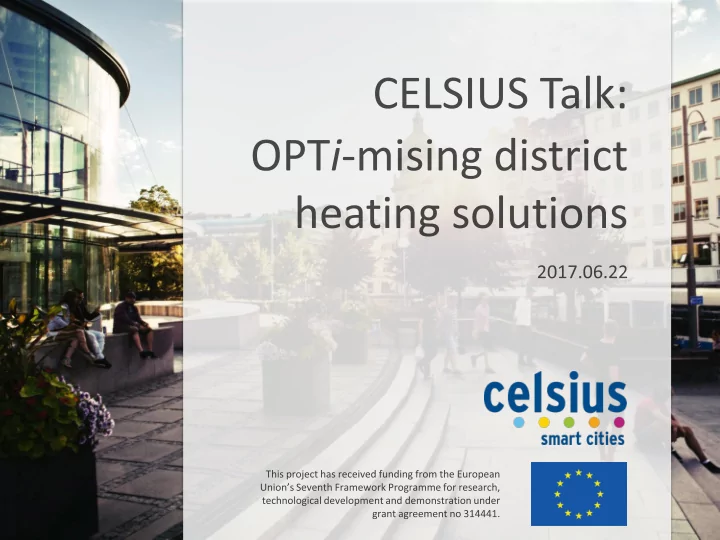

Demand Response • Demand Response programs are employed to alleviate energy demand peaks. In such programs consumers wilfully agree to reduce their energy consumption in return for an appropriate incentive. • Example case from our OPTi pilot Lulea, Sweden: • During peak hours the provider (Lulea Energy) activates a costly backup production plant (peak load generator) to meet the demand, by using alternative energy production. • Our objective: employ DR to avoid this activation of the backup plant at peak-demand times. • Major challenges • The uncertainty on the actual load curtailment to be attained by each consumer. • The estimation of the appropriate amount of incentives to motivate consumers to participate. • Designing customised ADR incentive-based contracts. • Automating the whole DR process (being non-intrusive at the same time).
OPTi‘s contribution in the area • Defined a methodology for designing efficient contract-based ADR programs considering consumers’ preferences and external context, e.g. weather. • Consumers are both compensated for a specified amount of energy curtailment and assigned an optimal schedule based on a consumer net benefit maximization approach (in a contractual way) • Developed algorithms to select the optimal set of consumers to be targeted for DR complemented by two policies that restrict in a different way the discomfort caused. • Methodologies were extended to exploit behavioral aspects like altruism in order to maximize social welfare. • Our work is tailored and evaluated both for electricity and district heating networks. • Developed the ADR tool for DR designers (prototype implementation).
Automated DR Design Tool (1/2) Summary • Developed in the context of OPTi and evaluated using experimental data sets from real environments. It is an asset for the utilities and DR designers. • The tool based on the predictions of the baseline estimation module and the objectives set for the ADR event, i.e. a) selects the optimal set of users to be targeted for ADR, and b) for each targeted user specifies the amount of incentives to be offered as a reimbursement for the discomfort caused, and the schedule for the set of appliances to be imposed in users’ premises. • Runs on a MATLAB engine with a user friendly Java UI and is part of the highest level of the OPTi approach (optimization of operation). High level architecture
Automated DR Design Tool (2/2) Relevant papers from OPTi partners: • M .Minou, G.D. Stamoulis, T.G. Papaioannou . “The effect of Altruism in Automated Demand Response for Residential Users”. In IEEE ISGT, 2017, Torino, Italy (accepted for publication) • M. Jain, V. Chandan, M. Minou, G. Thanos, T. K. Wijaya, A. Lindt and A. Gylling . “Methodologies for Effective Demand Response Messaging”. Proc. IEEE SmartGridComm, 2015, Miami, Florida DR design tool • M. Minou, G.D. Stamoulis, G. Thanos, and V. Chandan . “Incentives and – Targeting Policies for Automated Demand Response Contracts”. Proc. Objective IEEE SmartGridComm, 2015, Miami, Florida • M. Minou, E. Kaskantiri , G.D Stamoulis. “Discovering the Right Incentives for Demand Response Programs”. In Proceedings of the 2015 ACM Sixth International Conference on Future Energy Systems (pp. 271-276). ACM
Summary • In a simulation environment the results appear to be promising: • under specific settings and assumptions a provider can achieve a reduction in total peak demand by approximately 20% by limiting the comfort of consumers by only 10% while compensating them with a relatively low total amount of incentives. • 3 key challenges to be met for a DHC ADR-enabled network: 1. Automating the DR: Remote controlling of thermostats or the supply temperature (at users end). 2. Eliciting consumer feedback in a non-i ntrusive way (OPTi‘s approach: The “Virtual Knob”). 3. Incentives mechanisms design (behavioral triggers or price-based schemes?). • OPTi will provide suggestions on all of the above!
Recommend
More recommend